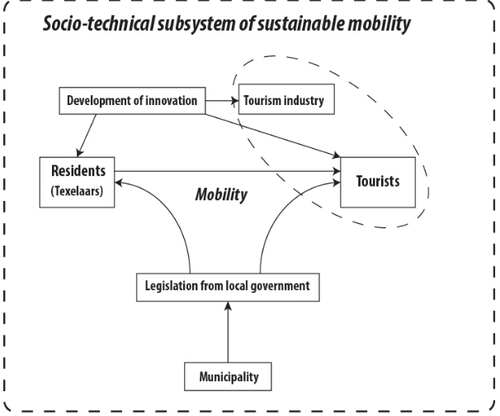The most important technology in the socio-technical subsystem of sustainable mobility, is the ferry connection between Texel and the mainland. This connection is the life-line of the island. The island benefits greatly from the influx of tourists (see figure 2.2.1), and the vast majority of these tourists come by ferry. Moreover, all the services and goods Texel needs to import come by ferry, but the ferry is also used for the exportation of goods.
On the island there are proper bus connections as a way of public transport. Still, the municipality of Texel strives to improve the bus connections by 2020, stimulating Texelaars and tourists to leave the car and make use of the public transport network. It also aspires to make public transport free during winter periods for school youth in the rural areas and for retired people all year long (Gemeente Texel, 2012). The municipality foresees a more dominant role for bicycle on the island in the near future. It wants to improve bicycle infrastructure and connections.

Figure 2.2.1. Map over the socio-technical mobility system.
Texel also has an airport. In the past there used to be some opposition against this airport, but it seems the Texelaars nowadays have embraced the airport and the opportunity it offers. According to the Texel municipality (2012), the airport should have a functional use however, to take people to and from the island, instead of a recreational use. The recreational use of the airport, such as parachute jumping using small noisy airplanes, can cause nuisance during tourist season.
How are the elements (technologies, industries, organizations, people in the system interrelated?
Residents: use of the socio-technical network, are depending on legislation from local governments, are depending on development of innovation in subsystem, have a strong relation with the tourism industry and will have to satisfy the users (tourists) of this industry by compelling a proper mobility system.
Tourists: Also use the socio-technical network, although temporary. Are strongly depending on legislation with regards to car-use. Are depending on the municipality and the Texelaars for alternatives for car use and are depending on technological innovations (such as electrical bikes) to have proper alternatives for car use.
By which rules and regulations is the system organized?
On a national level, the system falls within the policy boundaries of the ministry of environment and infrastructure. This ministry is responsible on a national level for proper infrastructure connections over land, through water and air. The ferry connection Texel and Den Helder is such a connection. A lot of responsibilities are passed on to the province of Noord-Holland however. Under the province policy is executed on municipal level. In the case of Texel, the municipality has made a mobility plan in conjunction with the ‘dorpscommissies’ (committees of the villages), the TOP, the SIGT, Veilig Verkeer Nederland, the VVV and the TESO. Together they have identified a set of bottlenecks and opportunities and they have written guidelines and ambitions for the future mobility of Texel.
References
Gemeente Texel. (2012). Knelpuntenanalyse mobiliteit Texel 2012. Gemeente Texel. Texel.

